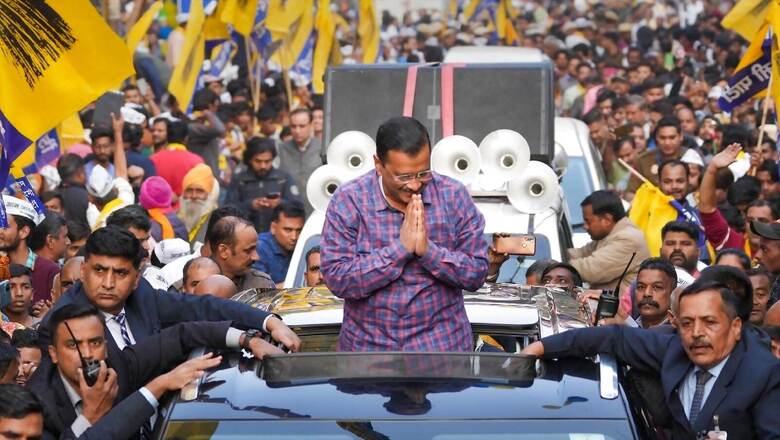
views
There is this famous couplet from Bhakti era saint Kabirdas which says: “Duvidha mein dou gaye, na Maya mili na Ram (when in two minds you neither get world pleasures, nor spiritual salvation).” The results of the Assembly elections in Gujarat and Himachal Pradesh and that of the Municipal Corporation of Delhi clearly indicate that while there were not many takers for the Aam Aadmi Party’s Hindu espousal, there was definite disenchantment in the minority community on the issue. The loss of Aam Aadmi Party (AAP) candidates in the minority-dominated wards of Delhi are a clear indicator. If there was any doubt, lesson was learnt when the AAP tried to poach on a few Muslim corporators from the Congress, who were brow beaten back by the local populace.
The AAP for the past few years had been working towards creating a pro-Hindu image for the party. The mention of putting images of Ganesh and Lakshmi on the currency notes was not a flash in the pan but a serious attempt at embarrassing the BJP leadership on matters of Hindu religion.
Arvind Kejriwal has been working towards creating a Hindu image for himself for the past some years. While the government schemes for arranging pilgrimage for the old and poor had been in existence for a while now, in 2019 the AAP gave it a new face. Advertisements came out showing Kejriwal as Hindu mythology character Shravan Kumar, known for his quality of serving old parents.
While these pilgrimages were held to different destinations, soon after the Supreme Court decision on Ram Mandir, Kejriwal’s government made the scheme largely Ayodhya-centric. This was in sharp contrast to an AAP Uttar Pradesh unit tweet in 2014, which claimed Arvind Kejriwal saying that his grandmother had told him that her Ram wouldn’t reside in a temple built on a broken mosque.
In the midst of the Covid crisis in the city in 2021, instead of preparing for taking on the new wave of pandemic, city’s Finance Minister Manish Sisodia was busy presenting a ‘Desh Bhakti’ budget to ape the BJP agenda of nationalism. Kejriwal went a step ahead, announcing during the budget discussion his plan for ‘Ram Rajya’ in the city and sending people on free pilgrimage to Ramjanambhoomi.
In November 2021, Kejriwal with his wife and cabinet colleagues had offered prayers at the replica of Ayodhya Ram Mandir built at Thyagraj Stadium in Delhi. The event was preceded by the usual publicity blitzkrieg and people were urged to witness the event live. It was part of Kejriwal’s bouquet to entice voters of Uttar Pradesh with his Ram Bhakti, which included free trips to the citizens of Delhi to Ayodhya.
Earlier to puja at the stadium, Kejriwal had even visited Ramjanambhoomi and Hanumangarhi in Ayodhya to reiterate his Ram bhakti not being of any lesser degree than that of the BJP leaders. It’s another matter that voters in UP did not buy into his bhakti.
He made a similar attempt during the just concluded Gujarat elections. Kejriwal started his Gujarat poll campaign in July this year by visiting the Somnath Temple. During the course of the campaign he ensured that he did not speak about issues like the Bilkis Bano case thinking it may disenchant the Hindu sentiments.
He did not stop at that and asked for images of much revered God and Goddess Ganesh and Lakshmi on currency notes to save it from its falling value. “As I said, we have to make a lot of effort to improve the economic situation of our country. Our efforts bear fruit when we have the blessings of Gods and Goddesses. The whole country will get blessings if on currency notes, there is a photo of Ganesh Ji and Lakshmi ji on one side and Gandhi ji on other side,” Kejriwal had said.
However, like UP, in Gujarat too, there were few takers for Kejriwal’s Ram Bhakti. The Delhi chief minister should realise that Ramjanmabhoomi movement was a vast programme which spread for over four decades. It took great struggle from the BJP cadres raising the issue inside and outside the court rooms and legislative bodies before the permission was given by the Supreme Court to build a Ram Temple on the land where once Babri Mosque stood.
This, however, cost the AAP minority votes in the Delhi municipal corporation polls. The party lost nine minority-dominated wards, with clear signs of the Muslim and to an extent Dalit voters shifting towards the Congress. There were at least 80 seats, which had a fair inkling of minority and Dalit votes, where Congress fought well and cut into AAP votes to make BJP win the wards as the saffron party managed to retain its core voters.
The lesson for Kejriwal is that his party can fill the vacuum wherever a Congress in decay would leave space. However, to match the vigour of an aggressive and on-the-roll BJP under the leadership of Prime Minister Narendra Modi was an insurmountable task. The AAP must know that the BJP’s constituency is well curated and thus difficult to break into.
The writer is an author and president, Centre for Reforms, Development & Justice. The views expressed in this article are those of the author and do not represent the stand of this publicaton.
Read all the Latest Opinions here




















Comments
0 comment